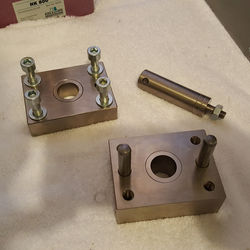ASTM B769
Shear Testing Aluminum Alloys


 |
|---|
 |
 |
 |
 |
 |
 |
🔍 Scope
ASTM B769 describes a standard method for measuring the shear strength of wrought and cast aluminum products using a double-shear test. It’s mainly used to determine the ultimate shear strength, which is the maximum stress the material can handle before fracturing in shear.
🧪 Application
This test helps engineers and designers:
-
Evaluate aluminum materials for structural applications (especially in aerospace).
-
Determine minimum material properties for design.
-
Understand performance in conditions not strictly pure shear, which is realistic since pure shear rarely occurs in actual structures.
⚠️ Note: Shear strengths from this method tend to be ~10% higher than those from ASTM B565, so the two methods are not interchangeable.
🧰 Brief Summary of Procedure
-
A cylindrical specimen is placed in a double-shear fixture.
-
The fixture is loaded in tension or compression using a testing machine (Universal Testing Machine).
-
The force needed to fracture the specimen in shear is measured and modeled with software.
-
Shear strength is calculated based on that load and the cross-sectional area.
🧷 Test Setup (Apparatus & Specimens)
-
Test Machine: Must meet ASTM E4 standards. (All of our testing machine models pass industry standards.)
-
Fixture: A double-shear test fixture made of hardened tool steel (Rockwell 60–62 HRC).
-
Specimen: Typically cylindrical, 3/16" to 1/2" in diameter, machined to tight tolerances.
-
Surface finish: ≤ 32 µin Ra.
-
Measurement precision: ±0.0005 in.
-
Die clearance: ≤ 0.0015 in.
-
-
Lubrication: Avoid it if possible—it can lower results by ~3%.
📐 Orientation & Direction
The test results depend on the grain direction of the aluminum. Specimen orientation is identified using two-letter codes:
-
First letter: direction normal to the shear plane
-
Second letter: direction of applied load
(e.g., L-S, T-S for plates; L-R, C-R for rods)
⚙️ Test Procedure
-
Clean the specimen and dies (acetone recommended).
-
Place in shear fixture.
-
Apply load using a crosshead speed ≤ 0.75 in/min.
-
Record max load at failure.
-
Clean dies between tests to remove aluminum buildup.
📊 Shear Strength Calculation
Shear strength SSS is calculated as:
S=2PmaxπD2S = \frac{2P_{max}}{\pi D^2}S=πD22Pmax
Where:
-
PmaxP_{max}Pmax = max load to fracture
-
DDD = average measured diameter of specimen
📝 What to Report
Your lab report must include:
-
Test method (ASTM B769)
-
Material and sample ID
-
Specimen diameter
-
Orientation & loading direction
-
Maximum load (lbf or N)
-
Calculated shear strength (ksi or MPa)
-
Test temperature
🔑 Keywords
-
Aluminum alloys
-
Shear strength
-
Double-shear test
-
Wrought and cast aluminum
*************************************************************************************************************
🔧 What ASTM B769 Is About
ASTM B769 is a test method used to measure the ultimate shear strength of aluminum alloys, including both wrought and cast forms. The test uses a double-shear setup, where a round aluminum specimen is loaded in a fixture and pulled or compressed until it fails by shearing.
🧪 How the Test Works
-
A cylindrical aluminum specimen is placed in a special tool (double-shear fixture).
-
It’s loaded using a tensile or compression testing machine until it breaks in shear.
-
The goal is to find out how much force it takes to cause shear failure—essential for understanding how strong the material is under such loading.
🧠 Why It Matters
-
It helps engineers design safer structures, especially for aircraft and aerospace parts.
-
Although the test doesn’t produce “pure shear” conditions (which are rare in real life anyway), the results are still reliable and useful for structural design.
-
Results from this method are typically about 10% higher than another similar method (ASTM B565), so the two shouldn't be mixed.
⚙️ Equipment and Setup
-
Fixture: A precision tool steel fixture that holds the specimen and applies load to two shear planes.
-
Testing Machine: Must meet ASTM’s machine calibration standards (ASTM E4).
-
Specimens:
-
Common size: 3/8 inch diameter
-
Must be precisely machined with tight tolerances
-
Orientation (grain direction) matters—specimens must be labeled properly
-
📐 Test Procedure in a Nutshell
-
Clean the specimen and the fixture.
-
Insert the specimen into the double-shear tool.
-
Load it at a controlled rate (no faster than 0.75 in/min).
-
Record the maximum force before the specimen shears.
-
Clean the dies afterward if there’s any aluminum buildup.
🧮 How Strength is Calculated
Shear strength is calculated with this formula:
Shear Strength=2×Max Loadπ×D2\text{Shear Strength} = \frac{2 \times \text{Max Load}}{\pi \times D^2}Shear Strength=π×D22×Max Load
Where:
-
DDD is the diameter of the specimen
-
Max load is the peak force before the break
📋 What Needs to Be Reported
A valid test report must include:
-
The method used (ASTM B769)
-
Sample details and dimensions
-
Orientation and loading direction
-
Maximum load
-
Calculated shear strength
-
Test temperature
🗂️ In Summary
This standard provides a reliable way to measure how aluminum alloys behave under shear loading—an important property for structural applications. It’s especially helpful for industries where high-performance metals are critical, such as aerospace and defense.
